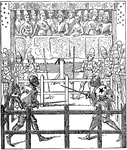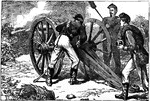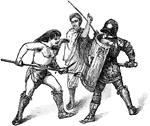Clipart tagged: ‘combat’

Battle of Azincourt
The Battle of Agincourt was an English victory against a larger French army in the Hundred Years' War.…

Battlefield
A battlefield refers to the location of a battle. Generally, a battle is a conceptual component in the…

Trial by Combat
"The trial by combat, or wager of battle, was a solemn judicial duel. It was resorted to in the belief…

Gladiators
This illustration shows various types of gladiators, each type with with his specific weapons attributed…

Tippecanoe Battle Ground in 1860
The Battle of Tippecanoe was fought in 1811 between United States forces led by Governor William Henry…




